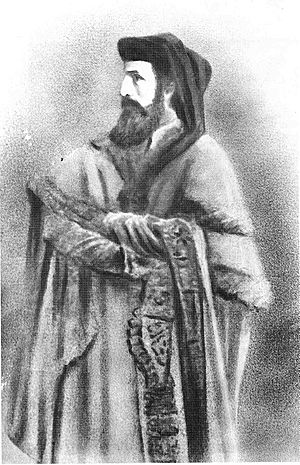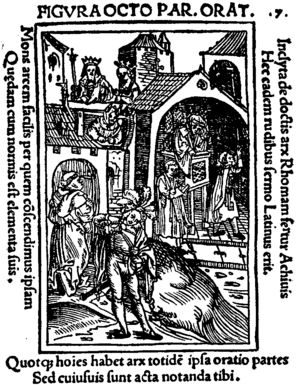Matthias Ringmann facts for kids
Matthias Ringmann (1482–1511) was a smart German scholar and poet. He was also known as Philesius Vogesigena. He studied the world and maps (a "cosmographer").
With another mapmaker, Martin Waldseemüller, he helped name the continent of America. They used the name on a map in 1507. It was named after the Italian explorer Amerigo Vespucci.
Contents
Matthias Ringmann's Life Story
Matthias Ringmann was born in 1482 in a small village called Eichhoffen, in Alsace. When he was 16, in 1498, he went to the University of Heidelberg. Later, he studied at the University of Paris.
He studied many subjects that were popular for scholars back then. These included Greek, Latin, old stories, history, math, and how to map the world. In 1505, he moved to Strassburg. There, he worked at a printing press. He also started studying an old book called Geography by Ptolemy.
Discovering the "New World"
In 1505, Ringmann found a booklet called Mundus Novus. It was written by Amerigo Vespucci. The booklet described Vespucci's trip along the coast of what is now Brazil. Ringmann knew that old writers had wondered if a huge, unknown continent was on the other side of the world. He became sure that Vespucci had found it.
Ringmann printed the booklet again. He gave it a new title: Concerning the Southern Shore Recently Discovered by the King of Portugal. In July 1507, he wrote a letter to a friend. In the letter, he called Vespucci "a great man of brave courage." He put this letter at the start of his reprinted book. Later that year, he went to Italy. He likely looked for more information about Vespucci and the lands he had explored.
Translating Ancient Texts
In 1506, Ringmann started another project. He worked on the first German translation of Julius Caesar's Commentaries on the Gallic War. He used Ptolemy's Geography to find the old Roman place-names. Then he matched them to places that existed at the time. His translation was published in 1507.
Working with the Gymnasium Vosagense
Meanwhile, a group of scholars was forming in Saint-Dié. This group was supported by René II, Duke of Lorraine. They called themselves the Gymnasium Vosagense. Their leader was Walter Lud. They wanted to publish a new version of Ptolemy's Geography.
Ringmann joined the group because he had worked with the Geography before. He also knew Greek and Latin well. Martin Waldseemüller, a mapmaker, was also hired. He was to draw and illustrate the maps for the new book.
Naming America
In 1506, the Gymnasium group got a French translation of the Soderini Letter. They also got a Portuguese sea map. This map showed the coast of lands recently found in the western Atlantic. Ringmann again thought this was the "new world" that old writers had talked about.
The Soderini Letter gave Vespucci credit for finding this new continent. It also suggested that the Portuguese map was based on his trips. The group decided to pause their work on the Geography. Instead, they would publish a short book called Introduction to Cosmography. It would come with a world map.
Ringmann wrote the Introduction. It included a Latin translation of the Soderini Letter. In a note at the start of the letter, Ringmann wrote:
I see no reason why anyone could properly disapprove of a name derived from that of Amerigo, the discoverer, a man of sagacious genius. A suitable form would be Amerige, meaning Land of Amerigo, or America, since Europe and Asia have received women's names.
A thousand copies of the Introduction and the world map were printed on April 25, 1507. This was the first time the word 'Americas' appeared in print. Later, after Ringmann died, Waldseemüller stopped using the name America. He called South America "Terra Nova." But the name America was already well-known.
Later Work and Illness
After 1507, Ringmann and Waldseemüller kept working together. They created a new edition of Ptolemy's Geography. In 1508, Ringmann went back to Italy. He found an important Greek manuscript of Ptolemy's work. With this, they seemed to finish their project. However, the new Ptolemy book was not published until after Ringmann's death. By 1509, Ringmann was very sick with tuberculosis. But he kept working.
A Game for Kids
In 1509, he published a card game called Grammatica Figurata. He made this game to make learning grammar rules more fun for children. He died in 1511 in Sélestat.
Grammatica Figurata
The Grammatica Figurata was first published by Matthias Ringmann in 1509. This work tried to make learning grammar more lively. It used illustrated card sets for each grammar rule. Children would have a set of these cards.
The rules were not explained in great detail. But some hints were given throughout the game. The last part, about "Exclamations," even had a sentence on how to tell which student had won. Each card showed a part of speech, a gender, a case, or a tense. Depending on the teacher's questions, a student would play the correct card or cards. For a long time, people thought Grammatica figurata was lost. But one copy was found and reprinted in 1905.
See also
 In Spanish: Mathias Ringmann para niños
In Spanish: Mathias Ringmann para niños



